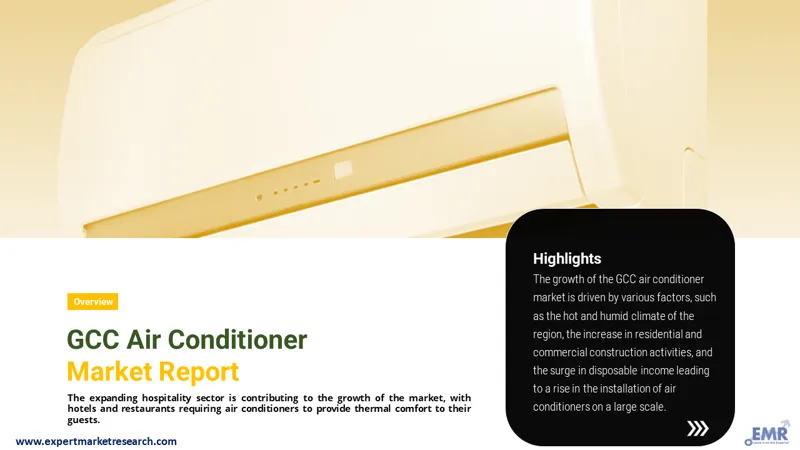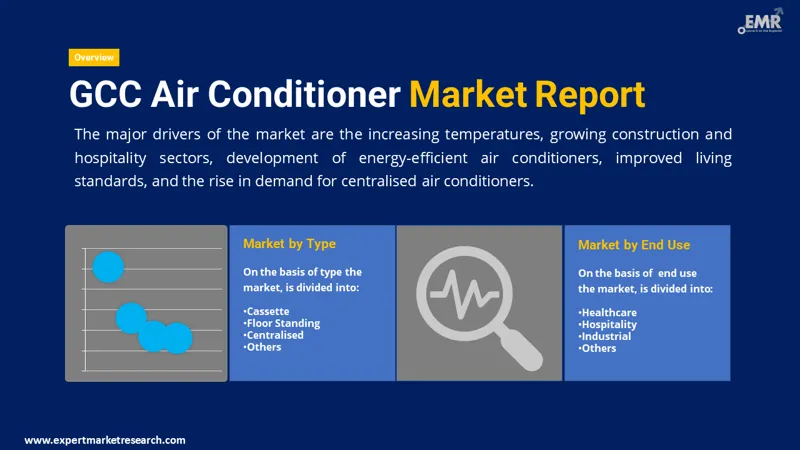
Consumer Insights
Uncover trends and behaviors shaping consumer choices today
Procurement Insights
Optimize your sourcing strategy with key market data
Industry Stats
Stay ahead with the latest trends and market analysis.
The GCC air conditioner market reached a value of about USD 4001.81 Million in 2025. The market is further estimated to grow at a CAGR of 3.90% in the forecast period of 2026-2035 to reach a value of around USD 5866.94 Million by 2035.
Base Year
Historical Period
Forecast Period
Compound Annual Growth Rate
3.9%
Value in USD Million
2026-2035
*this image is indicative*
| GCC Air Conditioner Market Report Summary | Description | Value |
| Base Year | USD Million | 2025 |
| Historical Period | USD Million | 2019-2025 |
| Forecast Period | USD Million | 2026-2035 |
| Market Size 2025 | USD Million | 4001.81 |
| Market Size 2035 | USD Million | 5866.94 |
| CAGR 2019-2025 | Percentage | XX% |
| CAGR 2026-2035 | Percentage | 3.90% |
| CAGR 2026-2035 - Market by Country | UAE | 4.2% |
| CAGR 2026-2035 - Market by Country | Bahrain | 4.0% |
| CAGR 2026-2035 - Market by Type | Cassette | 4.5% |
| CAGR 2026-2035 - Market by End Use | Health Care | 4.7% |
| Market Share by Country 2025 | Saudi Arabia | 36.1% |
Based on type, the demand for centralised air conditioners, owing to their exceptional benefits, is significantly increasing in the GCC region. Centralised AC plays a critical role in cooling the indoor area while lowering moisture levels and offers thermal comfort to the occupants, thereby increasing its adoption in the residential sector. Additionally, it can operate efficiently for years with minor routine maintenance, offers consistent temperature, and is convenient to use owing to the presence of a single control panel. These air conditioners provide space-saving options as they require no duct, and they combine the central heating system and the central air system in one cabinet, therefore eliminating the need for a separate indoor furnace. Further, the advanced filters in centralised air conditioners enable clean air circulation and eliminate airborne contaminants. These air conditioners provide a quieter operation as the compressor-bearing unit is mounted outside the building, resulting in their increased installation over window units. These factors are contributing to the growth of the GCC air conditioner market.

Read more about this report - REQUEST FREE SAMPLE COPY IN PDF
An air conditioner is utilised to cool and control the humidity of an inside space. The air conditioner takes the air of a space into the ducts through a vent, and the heat is removed from the air through the cool gas in the evaporator, which is then sent back into the enclosed space.
The market for air conditioner, by type, is divided into
Based on end use, the market is segmented into
Market Breakup by Region

Read more about this report - REQUEST FREE SAMPLE COPY IN PDF
| CAGR 2026-2035 - Market by | Type |
| Cassette | 4.5% |
| Packaged | 4.4% |
| Split | 2.7% |
| Window | XX% |
| Ducted Split | XX% |
| Others | XX% |
| CAGR 2026-2035 - Market by | End Use |
| Health Care | 4.7% |
| Hospitality | 4.4% |
| Commercial & Retail | 4.0% |
| Residential | XX% |
| Government & Transportation | XX% |
| Industrial | XX% |
| CAGR 2026-2035 - Market by | Country |
| UAE | 4.2% |
| Bahrain | 4.0% |
| Kuwait | 3.6% |
| Saudi Arabia | XX% |
| Oman | XX% |
| Qatar | XX% |
| 2025 Market Share by | Country |
| Saudi Arabia | 36.1% |
| Oman | XX% |
| Bahrain | XX% |
The increasing installation of air conditioners on a large scale can be attributed to the need for cooling amidst GCC's hot and humid climate and the surge in residential and commercial construction activities owing to rising disposable income. The expanding hospitality sector in the region is resulting in the increased demand for air conditioners in hotels and restaurants to provide thermal comfort to the guests. Additionally, the rapid development of energy-efficient air conditioners to meet the sustainability goals of the region is driving the GCC air conditioner market growth. For instance, in June 2023, an agreement was signed between Strata UAE, Hyperganic, and EOS GmbH to develop the world's most energy-efficient residential air conditioning (AC) unit as a step towards UAE’s efforts to achieve net-zero carbon emissions by 2050.
The strong presence of the market players in the region and their initiatives towards offering different types of air conditioners that meets the customer expectations are aiding the market growth. Over the forecast period, the development of smart and technologically advanced air conditioners that are equipped with Wi-Fi and can be controlled via smartphones is expected to aid the market.
The report gives a detailed analysis of the following key players in the GCC air conditioner market, covering their competitive landscape, capacity, and latest developments like mergers, acquisitions, and investments, expansions of capacity, and plant turnarounds:
The comprehensive EMR report provides an in-depth assessment of the market based on the Porter's five forces model along with giving a SWOT analysis.
Australia Air Conditioner Market




*While we strive to always give you current and accurate information, the numbers depicted on the website are indicative and may differ from the actual numbers in the main report. At Expert Market Research, we aim to bring you the latest insights and trends in the market. Using our analyses and forecasts, stakeholders can understand the market dynamics, navigate challenges, and capitalize on opportunities to make data-driven strategic decisions.*
Get in touch with us for a customized solution tailored to your unique requirements and save upto 35%!
In 2025, the GCC air conditioner market attained a value of nearly USD 4001.81 Million.
The market is assessed to grow at a CAGR of 3.90% between 2026 and 2035.
The market is estimated to witness a healthy growth in the forecast period of 2026-2035 to reach almost USD 5866.94 Million by 2035.
The major market drivers include the rising temperatures in the region, surge in residential and commercial construction activities, expanding hospitality sector, rapid development of energy-efficient air conditioners, improved living standards, and rising inclination towards centralised air conditioners.
The key trends guiding the growth of the market include the strong presence of the market players and increasing investments in the development of smart air conditioners.
The major regions are Saudi Arabia, the United Arab Emirates, Oman, Qatar, Kuwait, and Bahrain.
The significant types of air conditioner include window, split, packaged, ducted split, cassette, floor standing, and centralised.
The major end uses of air conditioner include residential, commercial and retail, healthcare, hospitality, government and transportation, and industrial.
The major players in the market are Carrier Global Corporation, Daikin Industries, Ltd., Mitsubishi Electric Corporation, LG Electronics Inc., Fujitsu General Limited, Toshiba Corporation, Trane Technologies Company, LLC, YORK, GREE Comfort, Zamil Air Conditioner, S.K.M. Air Conditioning LLC, and Awal Gulf Manufacturing Co., among others.
Explore our key highlights of the report and gain a concise overview of key findings, trends, and actionable insights that will empower your strategic decisions.
| REPORT FEATURES | DETAILS |
| Base Year | 2025 |
| Historical Period | 2019-2025 |
| Forecast Period | 2026-2035 |
| Scope of the Report |
Historical and Forecast Trends, Industry Drivers and Constraints, Historical and Forecast Market Analysis by Segment:
|
| Breakup by Type |
|
| Breakup by End Use |
|
| Breakup by Region |
|
| Market Dynamics |
|
| Trade Data Analysis |
|
| Competitive Landscape |
|
| Companies Covered |
|
| Report Price and Purchase Option | Explore our purchase options that are best suited to your resources and industry needs. |
| Delivery Format | Delivered as an attached PDF and Excel through email, with an option of receiving an editable PPT, according to the purchase option. |
Datasheet
One User
USD 2,999
USD 2,699
tax inclusive*
Single User License
One User
USD 4,399
USD 3,959
tax inclusive*
Five User License
Five User
USD 5,599
USD 4,759
tax inclusive*
Corporate License
Unlimited Users
USD 6,659
USD 5,660
tax inclusive*
*Please note that the prices mentioned below are starting prices for each bundle type. Kindly contact our team for further details.*
Flash Bundle
Small Business Bundle
Growth Bundle
Enterprise Bundle
*Please note that the prices mentioned below are starting prices for each bundle type. Kindly contact our team for further details.*
Flash Bundle
Number of Reports: 3
20%
tax inclusive*
Small Business Bundle
Number of Reports: 5
25%
tax inclusive*
Growth Bundle
Number of Reports: 8
30%
tax inclusive*
Enterprise Bundle
Number of Reports: 10
35%
tax inclusive*
How To Order

Select License Type
Choose the right license for your needs and access rights.

Click on ‘Buy Now’
Add the report to your cart with one click and proceed to register.

Select Mode of Payment
Choose a payment option for a secure checkout. You will be redirected accordingly.
Gain insights to stay ahead and seize opportunities.

Get insights & trends for a competitive edge.

Track prices with detailed trend reports.

Analyse trade data for supply chain insights.

Leverage cost reports for smart savings

Enhance supply chain with partnerships.

Connect For More Information
Our expert team of analysts will offer full support and resolve any queries regarding the report, before and after the purchase.
Our expert team of analysts will offer full support and resolve any queries regarding the report, before and after the purchase.
We employ meticulous research methods, blending advanced analytics and expert insights to deliver accurate, actionable industry intelligence, staying ahead of competitors.
Our skilled analysts offer unparalleled competitive advantage with detailed insights on current and emerging markets, ensuring your strategic edge.
We offer an in-depth yet simplified presentation of industry insights and analysis to meet your specific requirements effectively.
Share